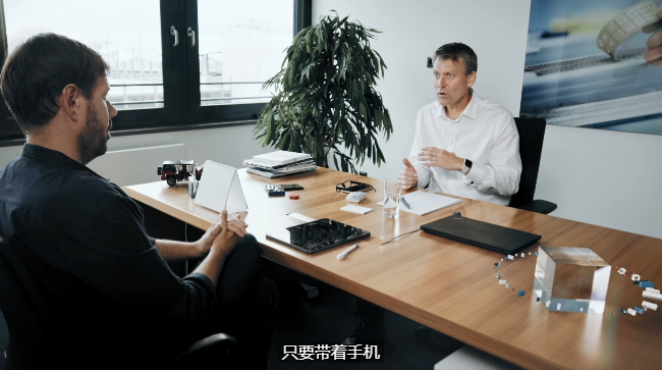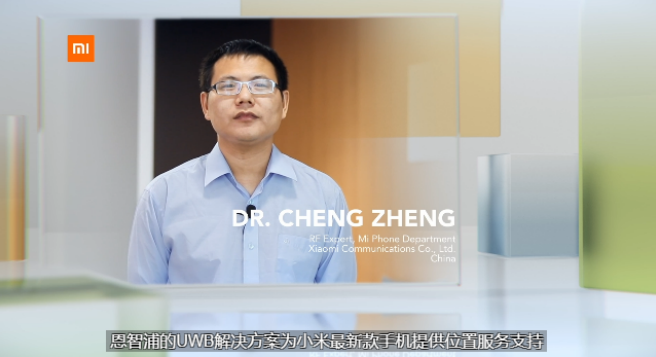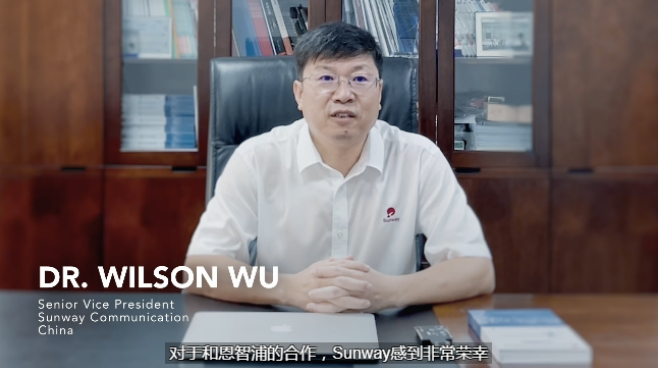Recently, due to the epidemic, NXP Connects conference was still held online. This is the second time NXP has held a developer conference online.
Last year's NXP Connects conference focused on a safer and smarter future. This year, NXP followed the "dual carbon" policy and proposed building a smarter and more sustainable world.
The biggest impression I got from the first NXP Connects in 2020 was that NXP's keynote speech could be so cool, using a lot of AR technology to let us see the technology of the future. At the 2021 Connects conference, I had another feeling, that is, NXP and its partners seamlessly explained to everyone what the world of edge intelligence and sustainability will be like in a more friendly, interactive and life-like way.

Of course, there are still AR renderings in this year's keynote speech, as shown on the right side of the picture
Gather your friends and head for four major directions
The keynote speech of this conference was conducted in the form of an interview with CTO Lars Reger. Lars said: "Considering the current critical nodes of social development and environmental changes on the earth, the biggest challenge of highly automated predictive capabilities is sustainability."
To this end, NXP has proposed to promote sustainability around four major innovation directions, namely perception, thinking, connection and action. NXP does not talk about all its products like advertising, but reflects NXP's innovation through customers telling about successful products and ideas. This is just as Steve Owen, executive vice president of sales and marketing at NXP, and Junko Yoshida, editor-in-chief of Ojo-Yoshida, said in a conversation that technicians are no longer only concerned about semiconductor technology itself, but are more concerned about how these technologies can improve the quality of life and work efficiency. This also requires semiconductor companies to think from the perspective of consumers about how semiconductors can help improve life and make things better.
Lars also mentioned that regarding innovation, what NXP needs to do is to "attract hundreds of innovators." And the people he connected with next were the representatives of these innovations.
The first was a connection with Claus Fleischer, CEO of Bosch eBike System. Bosch's eBike comprehensively reflects the four major directions proposed by NXP, including an intelligent torque sensing system, support for cloud anti-theft, and ensuring riding safety.

Lars and eBike
Afterwards, Lars connected with customers or NXP management and gave a detailed introduction to the progress in four major directions.
In terms of perception , Lars emphasized the seamless experience of UWB technology and connected with Dr. Zheng Cheng, RF expert of the mobile phone department of Xiaomi Communication Technology Co., Ltd., Qian Zhijun, vice president of marketing and sales of NXP Greater China, and Dr. Wu Huilin, senior vice president of Xinwei Communication. Zheng Cheng said that through NXP's differentiated products, Xiaomi can use TOF and AOA measurements to provide high-precision location perception. The two UWB products currently cooperated by the two parties are optimized for FiRa use cases and other IoT applications to help developers quickly start designs. Wu Huilin introduced that Xinwei Communication cooperated with NXP to develop UWB modules and provided Apple-approved evaluation kits to facilitate development, design and verification of iOS products.

Dr. Zheng Cheng, RF expert of the mobile phone department of Xiaomi Communication Technology Co., Ltd.

Dr. Huilin Wu, Senior Vice President of Sunway Communications
At the same time, Lars emphasized that UWB technology is not only used in the consumer market. Leading OEMs in the automotive market have also chosen this technology to develop systems such as keyless entry. In addition, it can be expanded to radar applications, including in-vehicle vital signs detection, automatic trunk opening and other functions, which are similar to the potential market use cases of millimeter-wave radar.
The drone market can also choose UWB technology for image mapping and landing detection, and even support landing on mobile platforms due to its fast and accurate characteristics.
In terms of thinking (processing) , the reduction of edge computing and energy efficiency is one of the most important challenges. Amanda McGregor, senior product director of NXP, took NXP's latest i.MX 93 series processor as an example, introducing this as an edge processor that integrates a secure root of trust, a neural network accelerator, and a multi-core Cortex-A55. It has good scalability and compatibility and is very suitable for industrial gateway applications. In addition, NXP also provides eIQ tools to facilitate edge artificial intelligence customers to carry out the full process of modeling, optimization, verification and deployment.
For connected applications , Lars invited Daniel Weyl, vice president of software development at NXP, and Bill Vass, vice president of technology at Amazon Web Services.
Lars introduced that the codes in today’s cars are more complex than fighter jet systems, so NXP needs to understand the entire system, divide large tasks into small tasks, and facilitate user development through plug-and-play methods while meeting mass production and safety requirements.
Daniel said that NXP separates software from complex hardware accelerators, and further reduces the difficulty of development for users by developing tool chains and model building, simulation, and emulation environments. Users only need to build their differentiated algorithms.
NXP's S32G automotive network processor supports AWS, which will allow automotive developers to better adopt cloud-native technologies to develop the next generation of software-defined vehicles and achieve a fast, simple and efficient development process.
Regarding actions , Lars took the charging of electric vehicles as an example, and respectively introduced to NXP Vice President and India Executive President Sanjay Gupta and ChargePoint Senior Vice President of Engineering Eric Sidle how NXP can achieve efficient charging management for both bicycles and cars through execution.
Sanjay said that the demand for electric bicycles in the Indian market is increasing day by day, and the Indian version of Didi Ola has also announced an ambitious plan to produce tens of millions of electric bicycles annually. The Ola version of the bicycle includes keyless start, a 7-inch TFT dashboard, voice recognition, and GPS, which caters to the aesthetic tastes of young Indians. In addition, Sanjay also said that NXP is actively reducing the cost of chargers for electric bicycles in response to the needs of the Indian market.
Eric said that ChargePoint is committed to building a software-defined charging platform, and NXP has reduced the burden on developers by providing a stable hardware platform and BSP (board support package). By supporting reused NXP software, it can be quickly imported on different hardware, which is suitable for companies that develop multiple product forms and multiple demand platforms.
Why should you care about edge AI?
Ron Martino, executive vice president and general manager of NXP's edge processing business unit, said that NXP expects there will be 50 billion connected devices in the world by 2025. If each device sends 1KB of data to the cloud every hour, it will be 1EB per year. Faced with the explosive growth of data and the increasing requirements for latency, privacy, etc., edge computing needs to introduce artificial intelligence to make data more valuable.
Ron said that NXP has developed a dedicated artificial intelligence engine to accelerate the introduction of neural networks, and integrated the NPU in the hardware to achieve more efficient neural network processing through matrix parallel computing.
Ron also emphasized that the tools for developing and deploying machine learning should be easy to use, especially with as little time as possible for testing, verification, and optimization. The eIQ development environment launched by NXP not only supports the construction and verification of artificial intelligence, but also allows comparison of results under different engines, making it easier for customers to compare results.
Make more Chinese partners
Different from the Connects conferences in North America and Europe, the Asia-Pacific region has specially added a special discussion on "Building China's Ecosystem and Winning the Intelligent Era", which was co-hosted by Dr. Li Tingwei, Chairman of NXP Greater China, Qian Zhijun, Vice President of Marketing and Sales for Greater China, and Liu Fang, General Manager of Automotive Electronics Business for Greater China.

Dr. Tingwei Li, Chairman of NXP Greater China
As Dr. Li Tingwei introduced, Greater China is one of NXP's most important markets, currently serving more than 6,000 customers. He said: "Chinese companies are moving towards the forefront of intelligence, automation and sustainable development. In order to meet the needs of the Chinese market, NXP's chips must be combined with software and hardware development to build applications that solve market needs and pain points, and jointly build an ecosystem to better serve the Chinese market."

Qian Zhijun, Vice President of Marketing and Sales, Greater China, NXP
Qian Zhijun deconstructed NXP's edge applications from multiple perspectives. NXP's understanding of edge applications includes industrial edge, 5G network, and IoT edge.
First of all , Qian Zhijun emphasized that NXP's products and solutions can serve the six major areas of new infrastructure. At the same time, NXP's high-performance and low-power solutions also conform to the dual-carbon development plan newly proposed this year.
Secondly , for 5G networks, NXP has a full product portfolio from antenna to network processors, including powerful product lines such as high-power LDMOS and gallium nitride, supporting open RF interfaces, new industry forms such as the O-RAN Alliance, etc. It can meet the needs of multiple markets, diversification, and fragmentation, including CU, DU, RU, ISC, CPE, and FWA. Tan Wei, vice president of research and development of Hangzhou Honglingtong Information Technology Co., Ltd., introduced the cooperation between the company and NXP in the small base station market. The two parties developed 5G small base stations around the programmable baseband processor LA1200. NXP provides high-performance multi-core Arm processors, and most of the optimized physical layer assembly code of the LA1200 series is completed by Honglingtong.
Previous article:The United States has included 12 Chinese companies including Gokewei and H3C on the "Entity List"
Next article:Nvidia's acquisition of Arm faces greater scrutiny
Recommended ReadingLatest update time:2024-11-16 10:24





- Allegro MicroSystems Introduces Advanced Magnetic and Inductive Position Sensing Solutions at Electronica 2024
- Vietnam's chip packaging and testing business is growing, and supply-side fragmentation is splitting the market
- The US asked TSMC to restrict the export of high-end chips, and the Ministry of Commerce responded
- ASML predicts that its revenue in 2030 will exceed 457 billion yuan! Gross profit margin 56-60%
- ASML provides update on market opportunities at 2024 Investor Day
- It is reported that memory manufacturers are considering using flux-free bonding for HBM4 to further reduce the gap between layers
- Intel China officially releases 2023-2024 Corporate Social Responsibility Report
- Mouser Electronics and Analog Devices Launch New E-Book
- AMD launches second-generation Versal Premium series: FPGA industry's first to support CXL 3.1 and PCIe Gen 6
- Innolux's intelligent steer-by-wire solution makes cars smarter and safer
- 8051 MCU - Parity Check
- How to efficiently balance the sensitivity of tactile sensing interfaces
- What should I do if the servo motor shakes? What causes the servo motor to shake quickly?
- 【Brushless Motor】Analysis of three-phase BLDC motor and sharing of two popular development boards
- Midea Industrial Technology's subsidiaries Clou Electronics and Hekang New Energy jointly appeared at the Munich Battery Energy Storage Exhibition and Solar Energy Exhibition
- Guoxin Sichen | Application of ferroelectric memory PB85RS2MC in power battery management, with a capacity of 2M
- Analysis of common faults of frequency converter
- In a head-on competition with Qualcomm, what kind of cockpit products has Intel come up with?
- Dalian Rongke's all-vanadium liquid flow battery energy storage equipment industrialization project has entered the sprint stage before production
- Allegro MicroSystems Introduces Advanced Magnetic and Inductive Position Sensing Solutions at Electronica 2024
- Car key in the left hand, liveness detection radar in the right hand, UWB is imperative for cars!
- After a decade of rapid development, domestic CIS has entered the market
- Aegis Dagger Battery + Thor EM-i Super Hybrid, Geely New Energy has thrown out two "king bombs"
- A brief discussion on functional safety - fault, error, and failure
- In the smart car 2.0 cycle, these core industry chains are facing major opportunities!
- The United States and Japan are developing new batteries. CATL faces challenges? How should China's new energy battery industry respond?
- Murata launches high-precision 6-axis inertial sensor for automobiles
- Ford patents pre-charge alarm to help save costs and respond to emergencies
- New real-time microcontroller system from Texas Instruments enables smarter processing in automotive and industrial applications
- Bistable switch circuit diagram
- [Very practical] Hands-on teaching of circuit board debugging skills
- Isn't the remainder % correct? Also, why are the TH0 and TL0 registers both set to 256-t?
- GCC GD32E230 toolchain startup and linking files
- IoT architecture and technology protocols
- Review Weekly Report 20221010: Sipeed GW2A FPGA development board and Renesas ultra-low power MCU RA2L1 are here~
- Why can a Zener diode break down with a reverse current of just a few volts, but a rectifier diode cannot break down with a reverse current of more than 200 volts?
- Semiconductor Recruitment-Shanghai, Shenzhen, Hangzhou
- Things to note when configuring 4G router ports
- Four major reasons for the heating of power modules



 NXP Automotive Grade Selection Manual
NXP Automotive Grade Selection Manual Talk about chips
Talk about chips
















 京公网安备 11010802033920号
京公网安备 11010802033920号